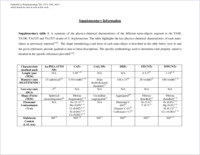Can the Ames test provide an insight into nano-object mutagenicity? Investigating the interaction between nano-objects and bacteria
- Clift, Martin J. D. Adolphe Merkle Institute and Fribourg Center for Nanomaterials, University of Fribourg, Switzerland
- Raemy, David O. Adolphe Merkle Institute and Fribourg Center for Nanomaterials, University of Fribourg, Switzerland
- Endes, Carola Adolphe Merkle Institute and Fribourg Center for Nanomaterials, University of Fribourg, Switzerland
- Ali, Zulqurnain Department of Physics, Philipps University Marburg, Germany
- Lehmann, Andrea D. Institute of Anatomy, University of Bern, Switzerland
- Brandenberger, Christina Institute of Anatomy, University of Bern, Switzerland
- Petri-Fink, Alke Adolphe Merkle Institute and Fribourg Center for Nanomaterials, University of Fribourg, Switzerland
- Wick, Peter Empa, Materials-Biology Interactions Laboratory, St. Gallen, Switzerland
- Parak, Wolfgang J. Department of Physics, Philipps University Marburg, Germany
- Gehr, Peter Institute of Anatomy, University of Bern, Switzerland
- Schins, Roel P. F. IUF - Leibniz Research Institute for Environmental Medicine, Duesseldorf, Germany
- Rothen-Rutishauser, Barbara Adolphe Merkle Institute and Fribourg Center for Nanomaterials, University of Fribourg, Switzerland - Respiratory Medicine, Bern University Hospital, Bern, Switzerland
-
2013
Published in:
- Nanotoxicology. - 2013, vol. 7, no. 8, p. 1373–1385
English
The aim of this study was to assess the interaction of a series of well characterised nano-objects with the Gram negative bacterium Salmonella typhimurium, and how such an interaction may relate to the potential mutagenicity of nano-objects. Transmission electron microscopy showed that nano-objects (Au-PMA-ATTO NPs, CeO₂ NPs, SWCNTs and MWCNTs), as well as CAFs entered S. typhimurium. Only DEPs did not penetrate/enter the bacteria, however, were the only particle stimulus to induce any significant mutagenicity through the Ames test. Comparison with a sophisticated 3D in vitro cell model showed CAFs, DEPs, SWCNTs and MWCNTs to cause a significant increase in mammalian cell proliferation, whilst both the Au-PMA-ATTO NPs and CeO₂ NPs had not significant adverse effects. In conclusion, these results indicate that various of different nano-objects are able to penetrate the double-lipid bilayer of Gram negative bacteria, although the Ames test may not be a good indicator for nano-object mutagenicity.
- Faculty
- Faculté des sciences et de médecine
- Department
- AMI - Bio-Nanomatériaux
- Language
-
- English
- Classification
- Biological sciences
- License
-
License undefined
- Identifiers
-
- RERO DOC 208652
- DOI 10.3109/17435390.2012.741725
- Persistent URL
- https://folia.unifr.ch/unifr/documents/303314
Other files
Statistics
Document views: 147
File downloads:
- pdf: 326
- Supplementary material: 185

